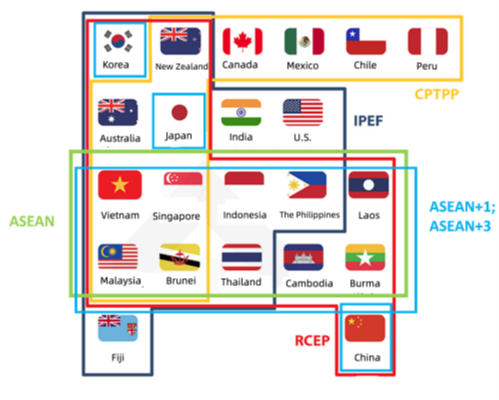The Transformative Shift in Global Economics Asia-Pacific's Ascendance and Evolving Trade Paradigms


Mr. Vivek Tiwari Mr. Ankit Pathak
Research Department - ECGC Limited
The global economic landscape has witnessed a transformative shift over the last three decades, with the Asia-Pacific (APAC) region's GDP share rising significantly while that of the European Union and the United States has declined. This evolution is marked by disruptions in the global value chain, leading to a reevaluation of trade strategies and the emergence of new economic frameworks, particularly in the APAC region.
The Indo-Pacific Economic Framework for Prosperity (IPEF), initiated by the USA, stands out as a pivotal development. In contrast to traditional free trade agreements, the IPEF involves 13 countries and focuses on trade, supply chains, clean energy, decarbonization, infrastructure, tax, and anti-corruption. It operates within a competitive geopolitical landscape, notably responding to the Regional Comprehensive Economic Partnership (RCEP), which, implemented in 2022, became the largest free trade zone outside the World Trade Organization (WTO).
The U.S.-China dynamics play a crucial role in this evolution. While China solidified its position as the region's largest economic superpower, the U.S. faced challenges in extending its hegemony. The launch of IPEF by the Biden administration, following the withdrawal from the Trans-Pacific Partnership (TPP), exemplifies the competitive nature of trade alliances in the Asia-Pacific region.
India's stance in this evolving scenario is noteworthy. Choosing to join IPEF after withdrawing from RCEP in 2019, India aligns with a vision of being a credible trading post with a partnership-oriented approach. However, challenges persist, particularly in protecting domestic industries, notably agriculture. India's participation in three out of four pillars of IPEF reflects a cautious approach, learning from past negotiations.

Figure 1: Evolving Economic Cooperation Mechanisms in the Asia-Pacific;
Source: Fangfei Jiang, An Analysis of the Indo-Pacific Economic Framework (IPEF): Essence, Impacts and Prospects
The complexities of this evolving economic landscape are further illustrated by the existence of multiple regional alliances in the Indo-Pacific region (refer figure 1). The juxtaposition of countries in these alliances, each with diverse objectives, underscores a zero-sum game where China has consolidated its position as the region's economic powerhouse.
In conclusion, the changing dynamics of global trade, especially in the Asia-Pacific region, are marked by the emergence of new economic frameworks like IPEF, responding to geopolitical shifts and disruptions. The competitive nature of alliances, the challenges faced by major economies, and the careful navigation of nations like India underscore the intricate interplay of geopolitics and trade dynamics shaping the future of global economic cooperation.
****************
Sources:
- S&P Global
- US Trade Representative website
- ASEAN Portal
- Asia Pacific Economic Cooperation website
The detailed article can be found at the following link: